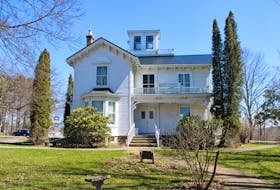It turns out those black birds led him to a white snowy owl.
Snowy owls usually live year-round in the Arctic, but may occasionally migrate south in the winter, as seems to be the case this year.
“I saw it just sitting there,” Lange said. “So I ran back to the truck, drove back home to grab my camera, went back down and she was still sitting there.”
He was able to snap some detailed shots of the majestic bird.
“They’ve been showing up all along the eastern seaboard and as far south as North Carolina,” said Lange. “There’s quite a few in Baccaro and Cape Sable Island with over 138 on Cape Race, Newfoundland.”
It has been suggested that a crash in the population of mice and lemmings in the North is the likely reason why the owls are forced to migrate south. The migration we are witnessing could be a sign that this year will not be an easy one for the owls.
“I believe that this is either female or a one-year-old juvenile with the dark markings,” said Lange.
Young owls, especially males, get whiter as they get older. Females are darker than males, with dusky spotting, and never become totally white. Some elderly males do become completely white, though many retain small flecks of dusky plumage.
Owls are known for their wide range and extensive travels. Lange’s brother in Edmonton, who has been a naturalist for many years, banded and put a radio transmitter on a snowy owl in Edmonton and it stayed in the area for about month.
“It then flew east to Prince Albert, Sask., then turned north and went all the way to Cambridge Bay, Nunavut.”
The International Union for the Conservation of Nature (IUCN), the world's main authority on the conservation status of species, list the owls as least threatened.
He recommends that if people see snowy owls in the county, they are advised to not get to close as they are stressed already with lack of food and having travelled thousands of miles from home.
“These birds rarely see people or cars since the Arctic is their home,” said Lange. “Take a telephoto, get pictures and let them rest.”
On Twitter: @NGNewsJohn
FACT BOX: THE SNOWY OWL
Name: Arctic owl, great white owl, snow owl.
Synonyms: Bubo scandiacus, Nyctea scandiaca.
Height: Up to 27 inches.
Length: 20-27 inches (wingspan of 4.5 to 5.5 feet).
Weight: 40-70 ounces; males smaller than females.
Did you know…
– The oldest snowy owl living in the wild was recorded to be nine years and five months. A captive snowy owl lived for at least 28 years.
– This largest (by weight) North American owl
The Snowy Owl is the official bird of the province of Quebec.
*Source: National Geographic*
It turns out those black birds led him to a white snowy owl.
Snowy owls usually live year-round in the Arctic, but may occasionally migrate south in the winter, as seems to be the case this year.
“I saw it just sitting there,” Lange said. “So I ran back to the truck, drove back home to grab my camera, went back down and she was still sitting there.”
He was able to snap some detailed shots of the majestic bird.
“They’ve been showing up all along the eastern seaboard and as far south as North Carolina,” said Lange. “There’s quite a few in Baccaro and Cape Sable Island with over 138 on Cape Race, Newfoundland.”
It has been suggested that a crash in the population of mice and lemmings in the North is the likely reason why the owls are forced to migrate south. The migration we are witnessing could be a sign that this year will not be an easy one for the owls.
“I believe that this is either female or a one-year-old juvenile with the dark markings,” said Lange.
Young owls, especially males, get whiter as they get older. Females are darker than males, with dusky spotting, and never become totally white. Some elderly males do become completely white, though many retain small flecks of dusky plumage.
Owls are known for their wide range and extensive travels. Lange’s brother in Edmonton, who has been a naturalist for many years, banded and put a radio transmitter on a snowy owl in Edmonton and it stayed in the area for about month.
“It then flew east to Prince Albert, Sask., then turned north and went all the way to Cambridge Bay, Nunavut.”
The International Union for the Conservation of Nature (IUCN), the world's main authority on the conservation status of species, list the owls as least threatened.
He recommends that if people see snowy owls in the county, they are advised to not get to close as they are stressed already with lack of food and having travelled thousands of miles from home.
“These birds rarely see people or cars since the Arctic is their home,” said Lange. “Take a telephoto, get pictures and let them rest.”
On Twitter: @NGNewsJohn
FACT BOX: THE SNOWY OWL
Name: Arctic owl, great white owl, snow owl.
Synonyms: Bubo scandiacus, Nyctea scandiaca.
Height: Up to 27 inches.
Length: 20-27 inches (wingspan of 4.5 to 5.5 feet).
Weight: 40-70 ounces; males smaller than females.
Did you know…
– The oldest snowy owl living in the wild was recorded to be nine years and five months. A captive snowy owl lived for at least 28 years.
– This largest (by weight) North American owl
The Snowy Owl is the official bird of the province of Quebec.
*Source: National Geographic*








